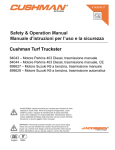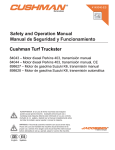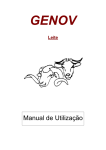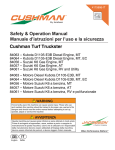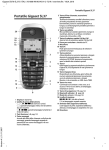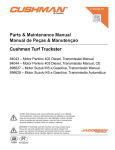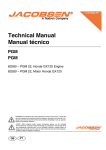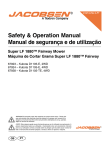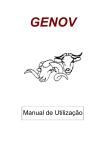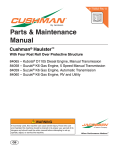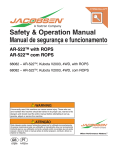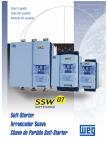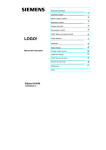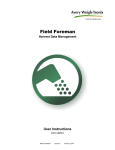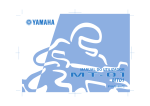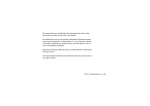Download warning - Jacobsen
Transcript
4140040-PT Safety and Operation Manual Manual de Segurança e de Funcionamento Cushman Turf Truckster 84043 – Motor Perkins 403 Diesel, Transmissão Manual 84044 – Motor Perkins 403 Diesel, Transmissão Manual, CE 898627 – Motor Suzuki K6 a Gasolina, Transmissão Manual 898628 – Motor Suzuki K6 a Gasolina, Transmissão Automática CONTENTS 1 CONTENTS 1 . . . . . . . . . . . . . . . . . . . . . . . . . . . . . . . . . . CONTENTS 2 . . . . . . . . . . . . . . . . . . . . . . . . . . . . . . . . . . . . . SAFETY 2.1 Operating Safety .................................................. 3 2.2 Important Safety Notes ........................................ 3 3 . . . . . . . . . . . .VEHICLE IDENTIFICATION NUMBERS 3.1 Vehicle Identification Number .............................. 5 3.2 Engine Identification Numbers ............................. 5 4 . . . . . . . . . . . . . . . . . . . . . . . . . . . . . . . . . . . . DECALS 4.1 Decals.................................................................. 6 5 . . . . . . . . . . . . . . . . . . . . . . . . . . . . . . . . . . CONTROLS 5.1 Icons .................................................................... 7 5.2 Control Descriptions ............................................ 9 6 . . . . . . . . . . . . . . . . . . . . . . . . . . . . . . . . . OPERATION 6.1 Daily Inspection ................................................. 12 6.2 Interlock System ................................................ 12 6.3 Operating Procedures ....................................... 13 6.4 Starting .............................................................. 14 6.5 To Drive Vehicle ................................................ 15 6.6 Ground Speed ................................................... 16 6.7 Stopping and Parking the Vehicle ..................... 17 6.8 Tire Pressure ..................................................... 17 6.9 Hydraulic System ............................................... 18 6.10 Engine Overheat Procedure .............................. 19 6.11 Towing the Vehicle ............................................ 19 6.12 Hillside Operation .............................................. 20 6.13 Daily maintenance ............................................. 20 7 . . . . . . . . . . . . . . . . . . . . . . . . . . . . . . . . . . . . . NOTES Proposition 65 Warning Engine exhaust from this product contains chemicals known to the State of California to cause cancer, birth defects, and other reproductive harm © COPYRIGHT 2005, TEXTRON INC. “All rights reserved, including the right to reproduce this book or portions thereof in any form”. All information in this publication is based on information available at time of approval for printing. Jacobsen reserves the right to make changes at any time without notice and without incurring any obligation. LITHO IN U.S.A. 8-2005 GB-2 SAFETY 2 2.1 2 SAFETY OPERATING SAFETY ______________________________________________________ ! WARNING EQUIPMENT OPERATED IMPROPERLY OR BY UNTRAINED PERSONNEL CAN BE DANGEROUS. Familiarize yourself with the location and proper use of all controls. Inexperienced operator’s should receive instruction from someone familiar with the equipment before being allowed to operate the machine. 1. 2. 3. 4. 5. 6. Safety is dependent upon the awareness, concern and prudence of those who operate or service the equipment. Never allow minors to operate any equipment. It is your responsibility to read this manual and all publications associated with this equipment (Parts & Maintenance manual, engine manual, accessories and attachments). If the operator can not read English it is the owner’s responsibility to explain the material contained in this manual to them. Learn the proper use of the machine, the location and purpose of all the controls and gauges before you operate the equipment. Working with unfamiliar equipment can lead to accidents. Never allow anyone to operate or service the machine or its attachments without proper training and instructions; or while under the influence of alcohol or drugs. Wear all the necessary protective clothing and personal safety devices to protect your head, eyes, ears hands and feet. Operate the machine only in daylight or in good artificial light. Evaluate the terrain to determine what accessories and attachments are needed to properly and safely perform the job. Only use accessories and attachments approved by Jacobsen. 12. Never disconnect or bypass any switch. 13. Do not change the engine governor setting or overspeed the engine 14. Carbon monoxide in the exhaust fumes can be fatal when inhaled. Never operate the engine without proper ventilation or in an enclosed area. 15. Fuel is highly flammable, handle with care. 16. Keep the engine clean. Allow the engine to cool before storing and always remove the ignition key. 17. Place transmission in neutral, depress clutch and engage parking brake before starting the engine (motor). Start the engine only when sitting in operator’s seat, never while standing beside the unit. 18. Equipment must comply with the latest federal, state, and local requirements when driven or transported on public roads. Watch out for traffic when crossing or operating on or near roads. 19. Local regulations may restrict the age of the operator. 20. Operate the machine up and down the face of the slopes (vertically), not across the face (horizontally). 21. To prevent tipping or loss of control, do not start or stop suddenly on slopes. Reduce speed when making sharp turns. Use caution when changing directions. 7. Stay alert for holes in the terrain and other hidden hazards. 22. Always use the seat belt when operating vehicles equipped with a ROPS. 8. Inspect the area where the equipment will be used. Pick up all the debris you can find before operating. Beware of overhead obstructions (low tree limbs, electrical wires, etc.) and also underground obstacles (sprinklers, pipes, tree roots, etc.) Enter a new area cautiously. Stay alert for hidden hazards. Never use a seat belt when operating vehicle without a ROPS. 9. Never allow anyone near the machine while in operation. The owner/operator can prevent and is responsible for injuries inflicted to themselves, to bystanders and damage to property. 23. Keep legs, arms and body inside the compartment while the vehicle is in motion. seating 24. Always shift transmission to Neutral (Manual Transmission) or Park (Automatic Transmission) and engage parking brake before leaving the vehicle. 10. Do not carry passengers. Keep bystanders and pets a safe distance away. 11. Never operate equipment that is not in perfect working order or is without decals, guards, shields or other protective devices securely fastened in place. GB-3 2 SAFETY 2.2 ! IMPORTANT SAFETY NOTES________________________________________________ This safety alert symbol is used to alert you to potential hazards. DANGER - Indicates an imminently hazardous situation which, if not avoided, WILL result in death or serious injury. WARNING - Indicates a potentially hazardous situation which, if not avoided, COULD result in death or serious injury. CAUTION - Indicates a potentially hazardous situation which, if not avoided, MAY result in minor or moderate injury and property damage. It may also be used to alert against unsafe practices. For pictorial clarity, some illustrations in this manual may show shields, guards or plates open or removed. Under no circumstances should this equipment be operated without these devices securely fastened in place ! WARNING The Interlock system on this vehicle prevents the vehicle from starting unless the clutch pedal is depressed (Manual Transmission) or gear selector is in Park (P) or Neutral (N) (Automatic Transmission). NEVER operate vehicle unless the Interlock system is working. ! WARNING 1. Before leaving the operator’s position for any reason: a. b. c. d. e. f. Remove foot from accelerator pedal. Slow vehicle using service brake. Depress clutch and shift transmission to neutral (Manual Transmission) or park (Automatic Transmission). Engage parking brake. Stop engine and remove the ignition key. One engine stops completely, shift manual transmission into First Gear. 2. Keep hands, feet, and clothing away from moving parts. Wait for all movement to stop before you clean, adjust or service the machine. 3. Keep the area of operation clear of all bystanders and pets. 4. Never carry passengers, unless a seat is provided for them. By following all instructions in this manual, you will prolong the life of your machine and maintain its maximum efficiency. Adjustments and maintenance should always be performed by a qualified technician. If additional information or service is needed, contact your Authorized Jacobsen Dealer who is kept informed of the latest methods to service this equipment and can provide prompt and efficient service. Use of other than original or authorized Jacobsen parts and Accessories will void the warranty. GB-4 VEHICLE IDENTIFICATION NUMBERS 3 3.1 3 VEHICLE IDENTIFICATION NUMBERS VEHICLE IDENTIFICATION NUMBER __________________________________________ The Vehicle Identification Number (VIN), consisting of the model number, date code and serial number are all printed on the Nameplate/Identification Decal attached to the cross member under the dash. This vehicle may be covered by one or more of the following U.S. patents: GOLF, TURF & SPECIALTY PRODUCTS The serial number is also stamped on the cross member. It is located to the left of the Nameplate/Identification Decal. NOTE: Reference to the Front, Rear, Left and Right sides of the vehicle are always determined by the operator’s seated position. Record the Vehicle Identification information below for easy reference. Augusta Georgia, USA 1 800 241 5855 MODEL 84043 DATE CODE M1903 LABEL # 75984G55 SERIAL # *2128855* Lb/kg W Batt Nom Power Hp/kw Model Number: ______________________ Figure 3A Always provide the Vehicle Identification Number of the Date Code: _________________________ unit when ordering replacement parts or requesting service information. Vehicle Identification Numbers must appear Serial Number: _____________________ on all correspondence concerning this vehicle. 3.2 ENGINE IDENTIFICATION NUMBERS _________________________________________ The Truckster is equipped with either a Perkins 3 cylinder, diesel powered, liquid cooled, four cycle engine or a Suzuki 3 cylinder, gas powered, liquid cooled, four cylinder engine. The Engine Serial Number for the Perkins engine is stamped onto the engine block on the right side of the engine near the alternator. The Engine Serial Number for the Suzuki engine is stamped onto the upper engine block on the right side of the engine, under the engine mount and may be partially hidden by the electrical harness. The serial number is also hand printed on the fuel rail. Engine Serial No. Perkins Diesel Record the Engine Serial Number below for easy reference. Figure 3B Engine Serial Number: _________________________ Engine Serial No. K6A Suzuki GB-5 4 DECALS 4 DECALS 4.1 DECALS _________________________________________________________________ Familiarize yourself with the decals. They are critical to the safe operation of the machine. REPLACE DAMAGED DECALS IMMEDIATELY. NOTICE THIS UNIT IS NOT A MOTOR VEHICLE WITHIN THE DEFINITION OF THE NATIONAL TRAFFIC MOTOR VEHICLE SAFETY ACT. IT IS NOT DESIGNED OR MANUFACTURED FOR USE ON ROADS, STREETS OR HIGHWAYS, NOR IS IT APPROPRIATE FOR SUCH USE. IT IS NOT MEANT TO BE LICENSED AS A MOTOR VEHICLE ! WARNING PARKING BRAKES ARE NOT AUTOMATICALLY APPLIED. VEHICLE MAY MOVE CAUSING PERSONAL INJURY AND/OR PROPERTY DAMAGE. ALWAYS APPLY HAND OR FOOT BRAKES 822819 821071 ! WARNING FAILURE TO HEED THESE WARNINGS MAY RESULT IN SERIOUS INJURY OR DEATH Part of 845038 STOP 2702014 Operator’s Manual Warning This decal informs the operator to read the Operator’s manual before attempting to start or operate the vehicle. 009034880 Electric Cooling Fan Warning This decal warns the operator that the cooling fan may start at any time even with the ignition key in the OFF position. 840754 Radiator Coolant Warning This decal warns the operator not to remove the radiator cap when the engine is hot. Refer to the Cooling System Section of the Parts & Maintenance manual for proper safety and operating instructions 1. Read and understand all labels and the Operator’s manual 8. Shift into neutral or park before starting engine. 2. Do not allow untrained personnel to operate this vehicle. 9. Only carry passengers in seats provided. 3. Do not modify this vehicle without manufacturer’s authorization. 10. When parking (Leaving) vehicle, follow all instructions in 4. Place loads forward of rear axle Operator’s manual. Failure to heed these 5. Top heavy loads can cause upsetting. Do not exceed payload 11. Avoid sudden starts, stops and sharp turns especially on slopes or warnings may result in capacity. with heavy loads. serious injury or death. 6. Do not operate if repairs are required. 12. Keep all labels and instructional literature legible and intact. 7. Keep all shields in place 13. Keep arms and legs within vehicle body. WARNING GB-6 CONTROLS 5 5.1 5 CONTROLS ICONS ___________________________________________________________________ Read Manual Hour Meter Engine Throttle High Low ACC Ignition Switch Off ON Start STOP Coolant Temperature Brake Parking Service Fuel Governor Control Throttle Governor ! Glow Plug Turn Indicators Left Right High Beam Engine Oil Pressure ! WARNING Never attempt to drive this vehicle unless you have read the Safety and Operation Manual and know how to operate all controls correctly. Familiarize yourself with the icons shown above and what they represent. Learn the location and purpose of all the controls and gauges before operating this tractor. GB-7 5 CONTROLS A B C D E F G H J K L M N P R S T Tachometer Hour Meter Fuel Gauge Voltmeter Temperature Gauge Turn Signal Indicator Oil Pressure Light Glow Plug Light Service Brake Fluid Light Parking Brake Light High Beam Indicator Ignition Switch Gear Selector Accessory Power Plug Hand Throttle Governor Control Light Switch U V W X Y Z AA AB Y Z AB AA A E F F F 220 280 88 104 138 C 190 140 G 60 25 20 30 15 COOLANT 12 Side Panel Rotated 90 Degrees For Clarity 40 5 10 K 35 10 14 45 0 50 14 x 100 16 E H Horn Button Clutch Pedal Service Brake Pedal Accelerator Pedal Differential Shift Cable Parking Brake Lever Remote Hydraulics Control Hydraulic Lift Control ! 12 34 F HOURS L 0 0 0 0 0 0 J D B STOP C P M S R U X T W V N N P R N D 2 L Manual Transmission GB-8 Automatic Transmission CONTROLS 5.2 CONTROL DESCRIPTIONS __________________________________________________ F F 220 280 88 104 138 C 190 140 G 60 25 20 COOLANT 30 15 35 5 45 10 12 10 14 K 50 14 x 100 E ! L. High Beam Indicator - Indicates light switch (T) is in high beam position. 40 0 16 K. Parking Brake Light - Indicates parking brake is engaged. Do not drive unit without disengaging parking brake. A E F H 5 12 OFF ON 34 F HOURS L ACC 0 0 0 0 0 0 STOP START J D B C Figure 5A M A. Tachometer - Indicates the engine speed (x 100) in revolutions per minute (rpm). B. Hour Meter - Records the number of hours the unit has been operated. The hour meter is active when the ignition switch (M) is in the ON position. C. Fuel Gauge - Indicates the amount of fuel remaining in the tank. Do not allow the tank to run dry. D. Voltmeter - The voltmeter indicates the voltage level of the battery. Under normal operation it should display between 12 and 18 volts. A reading below 12 volts indicates the battery is not charging correctly and is being drained E. Water Temperature Gauge - Indicates engine coolant temperature. If temperature rises above 230° F (110° C), a buzzer located under dash will sound. F. Turn Signal Indicators - Used with optional turn signal kit. Left or right indicators flash when turn signal lever is moved to left or right position. Both indicators will flash when hazard button is pressed. G. Oil Pressure Light - Light will come on when ignition switch is turned to on position and will go out once engine starts. Do not continue to operate truck if light does not go out, or comes on during operation. H. Glow Plug Light - Diesel Engines Only, Indicates glow plug timer is active. Timer will operate for approximately 20 seconds while pre-heating glow plugs in engine. J. Service Brake Fluid Light - Indicates low fluid level in master cylinder reservoir. Fill with clean DOT 3 brake fluid. Figure 5B M. Ignition Switch - The ignition switch has four positions. ACC - OFF - ON - START. ACC (Accessory) Position - Allows use of various instruments and accessories without causing ignition system damage. OFF Position - Prevents function of all vehicle electrical power operated features except for the flasher (hazard), lights, and the radiator cooling fan. Switch must be in OFF position for key removal. ON Position - Key is placed in this position for normal engine operation. START Position - Hold key in start position to engage engine starter. Upon release, key will return to ON position automatically. Key must be returned to the OFF position before the starter can be reactivated. N. Gear Selector - The gear selector is used to shift transmission into desired gear. Refer to ground speed decal to determine required gear. Manual Transmission: Gear selector knob has the “H” shift pattern design molded into the top surface. “H” Shift Pattern 13 24 R Figure 5C GB-9 5 CONTROLS Automatic Transmission: Gear selector has six positions, Park (P), Reverse (R), Neutral (N), Drive (D), second (2) and Low (L). Engine will not start unless selector is in Park (P) or Neutral (N). Push in selector button when shifting from Park (P), shifting into Neutral (N) or when shifting from Drive (D) to second (2) or Low (L). R. Hand Throttle - Used to set engine speed for remote operations. Increasing hand throttle speed will depress accelerator pedal. Never attempt to drive the vehicle with the engine speed controlled by hand throttle. S. Governor Control - Used to lower pre-set governor rpm limits for hand and foot throttle operation. Push lever all the way up to use pre-set rpm limit. Pull lever down as required to lower maximum rpm. T. Selector Button P R N D 2 L Light Switch - The light switch is used to turn the headlights and taillight on. The switch has three positions, OFF, LOW BEAM, and HIGH BEAM. Push switch up one detent for LOW BEAM or push switch up two detents for HIGH BEAM. U. Horn Button - The horn button is located to the left of the steering wheel, below the dash panel. Depress to sound horn. Horn will not sound when the ignition switch is in the OFF position. Figure 5D P. Accessory Power Plug - Allows operation of approved 12 Volt accessories and attachments. To prevent excessive battery drain, only use 12 volt outlet with engine running. P ! CAUTION The 12 Volt Accessory outlet circuit is protected by a 15 Amp fuse. Do not attempt to use attachment(s) with a combined power rating greater than 180 Watts. To prevent the risk or burns or fire do not replace 15 amp fuse with a higher amperage rating fuse. X W V R S Figure 5F T U V. Clutch Pedal - Manual Transmission only: Used to disengage the power output from engine to transmission. This allows shifting of transmission gears. Do not attempt to shift gears without fully depressing clutch pedal. The clutch pedal is equipped with an interlock switch. This switch prevents the starter from operating unless the clutch is disengaged (the clutch pedal is depressed). See 6.2 Figure 5E GB-10 CONTROLS W. Service Brake Pedal - Depress the pedal to slow or stop the vehicle. 5 If the brakes DO NOT stop the vehicle properly, the brakes must be adjusted or repaired. Z. Parking Brake Lever - The park brake lever is located to the left side of the drivers seat. To engage the brake, pull up on the lever until park brake is applied. X. Accelerator Pedal - Push pedal down to open throttle (increase speed), release to return throttle to idle position (decrease speed). To release; while slightly pulling up on the handle, push the button at the end of the lever and while holding the button in, lower the lever to it's original position. Y. Differential Shift Cable - Used to shift differential from LOW to HIGH speed range. Y Z AA.Remote Hydraulics Control - Used to engage and disengage remote hydraulic system. Push knob down to use lift control system and disengage remote hydraulics. Pull knob up to activate remote hydraulics and disable lift control system. AB.Lift Control System - Used to control hydraulic bed lift. Push Remote hydraulics control knob (AA) to activate hydraulic lift system. AB AA Pull back on the lever to extend the cylinder (Raise the dump box). Push forward on the lever to retract the cylinder (Lower the dump box). Push forward and to the right to place lever in float position. Figure 5G GB-11 6 6 OPERATION OPERATION 6.1 DAILY INSPECTION________________________________________________________ ! CAUTION The daily inspection should be performed only when the engine is off and all fluids are cold. Lower mowers to the ground, engage the parking brake, Stop engine and remove ignition key. 1. Perform a visual inspection of the entire unit, look for signs of wear, loose hardware, and missing or damaged components. Check for fuel or oil leaks to ensure connections are tight and hoses and tubes are in good condition. 6.2 2. Check the fuel supply, radiator coolant level, crankcase oil and air cleaner indicator. All fluids must be at the full level mark with engine cold. 3. Check tires for proper inflation. 4. Test the Interlock System. Note: For more detailed maintenance information, adjustments and maintenance/lube charts, see the Parts & Maintenance manual. INTERLOCK SYSTEM ______________________________________________________ 1. The Interlock System prevents the engine from starting unless the clutch pedal (Manual Transmission) is depressed, or shift lever (Automatic Transmission) is in Park (P) or Neutral (N). ! WARNING Never operate equipment with the Interlock System disconnected or malfunctioning. Do not disconnect or bypass any switch. Manual Transmission: Never turn the key to the START position unless the clutch pedal is depressed (pushed down) or the gear selector is in neutral. If the vehicle is in any gear other than neutral, and the clutch pedal is not depressed when the engine is started, the vehicle may lurch forward or backward depending which gear the vehicle is in. This lurching could cause serious personal injury or death. Automatic Transmission: Never turn the key to the START position unless the gear selector is in Park (P) or Neutral (N). If the vehicle is in any gear other than Park (P) or Neutral (N) when the engine is started, the vehicle may lurch forward or backward depending which gear the vehicle is in. This lurching could cause serious personal injury or death. 2. Perform each of the following two tests to insure the Interlock System is functioning properly. Stop the test and have the vehicle inspected and repaired if truck fails either test. GB-12 ● the engine does not start in test 1; ● the engine does start during tests 2; 3. Performed actions described for each test. Shut engine off between each test. Manual Transmission: Test 1: Represents normal starting procedure. The clutch pedal is depressed. The engine should start. Test 2: The engine must not start if the clutch pedal is not depressed. Automatic Transmission: Test 1: Represents normal starting procedure. the shift lever is in Park (P). The engine should start. Test 2: The engine should start if the shift lever is in Neutral (N). Test 3: The engine must not start if the shift lever is in Reverse (R). Test 4: The engine must not start if the shift lever is in Drive (D). Test 5: The engine must not start if the shift lever is in 2nd (2). Test 6: The engine must not start if the shift lever is in Low (L). OPERATION 6.3 6 OPERATING PROCEDURES _________________________________________________ ! WARNING A Rollover Protection Structure (ROPS) for this truck is available as an optional accessory. Evaluate the terrain and working conditions to determine if a ROPS is required. Seat belts must be worn whenever a ROPS is installed on the tractor. Always keep seat belt snugly adjusted. DO NOT use seat belts on a tractor without a ROPS. If a ROPS is installed and the vehicle is overturning, hold onto the steering wheel. Do not attempt to jump out or leave the seat. ! CAUTION To prevent injury, always wear safety glasses, leather work shoes or boots, a hard hat, and ear protection. Wear any protective equipment recommended by the chemical manufacturer. 1. Under no circumstances should the engine be started without the operator seated on the truck. 2. Do not operate truck or attachments with loose, damaged or missing components. Whenever possible spray when grass is dry. 3. Never remove or install the engine cover while the engine is running. The engine cover is a machinery guard and its removal exposes you to moving parts. Keep hands, hair and clothing away from flywheel, radiator cooling fan, alternator fan, engine belts, pulleys and air intake. ! WARNING Failure to latch the engine cover properly can result in the engine cover tipping forward causing loss of control of the vehicle and possible personal injury. 4. Study the area to determine the best and safest operating procedure. Consider the type of terrain, and condition of the surface. Each condition will require certain adjustments or precautions. 7. Slow down and look in both directions when crossing paths or roadways. Look out for traffic. 8. Stop and inspect the equipment for damage immediately after striking an obstruction or if the machine begins to vibrate abnormally. Have the equipment repaired before resuming operation. ! WARNING Before you clean, adjust, or repair this equipment, always disengage hydraulic system, engage parking brake, stop engine and remove key from ignition switch to prevent injuries. 9. Slow down and use extra care on hillsides. Read Section 6.12. Use caution when operating near drop offs. 10. Look behind and down before backing up to be sure the path is clear. Use care when approaching blind corners, shrubs, tress or other objects that may obscure vision. 5. Never direct discharge of material toward bystanders, nor allow anyone near the machine while in operation. The owner/operator is responsible for injuries inflicted to bystanders and/or damage to their property. ! CAUTION Before operating, pick up all debris such as rocks, toys and wire which can be thrown by the machine. Enter a new area cautiously. Always operate at speeds that allow you to have complete control of the truck. 6. Always disengage hydraulic system when not in use. GB-13 6 OPERATION 6.4 STARTING _______________________________________________________________ IMPORTANT: Do not use starting assist fluids. Use of such fluids in the air intake system may be potentially explosive or cause a “Runaway” engine condition and could result in serious engine damage. G Automatic Transmission: Sit in operator’s seat, make sure the parking brake is engaged and transmission is in Park (P). F F 220 280 88 104 138 C 190 140 60 25 20 30 15 COOLANT 1. Make sure fuel shut off valve is completely open. 2. Manual Transmission: Sit in operator’s seat, make sure the parking brake is engaged and transmission is in neutral.[See 5.2] Depress clutch pedal. [See 5.2 and 6.2] A E F 40 5 12 14 10 H 45 0 16 K 35 10 50 14 x 100 12 E ! 34 F L HOURS 0 0 0 0 0 0 J D C B 3. Turn ignition switch (M) to ON position. a. Engine Oil light (G) will come on and will stay on until engine starts. b. Diesel Engine: Glow plug light (H) will come on for up to 20 seconds. c. ON ACC STOP START Parking brake light (K) will be on when parking brake is engaged. 4. Diesel Engine: The diesel engine uses glow plugs to pre-heat the combustion chamber and makes cold starting easier. When starting the vehicle for the first time during the day, or when the engine has cooled, you will need to energize the glow plugs to start the engine. Energizing glow plugs is not necessary when starting a warm engine. When glow plug light (H) turns off, turn key (M) to START position. Release as soon as engine starts. Do not hold switch in the START position for more than 15 seconds. Make sure engine oil light (G) turns off. Turn key (M) to START position. Release as soon as engine starts. Do not hold switch in the START position for more than 15 seconds. Make sure engine oil light (G) turns off. 5. Allow the engine to become warm and properly lubricated before operating at high RPM. GB-14 OFF M Figure 6A OPERATION 6.5 6 TO DRIVE VEHICLE ________________________________________________________ Read and follow all safety notes contained in this manual when driving vehicle. Refer to Section 6.3 for general operating instructions. When operating in reverse look behind you to ensure you have a clear path. Important: If this truck is driven on public roads, it must comply with federal, state and local ordinances. Contact local authorities for regulations and equipment requirements. ! CAUTION To prevent tipping or loss of control, travel at reduced speed when making turns. Manual Transmission: 1. Disengage remove hydraulic system and fully lower the truck bed when driving to and from the area of operation. 2. Apply service brake and disengage parking brake. 3. The gear selector has an "H" pattern as shown in (there is also a shift-pattern design molded into the top of the gear selector handle). 4. With the clutch pedal fully depressed, select the appropriate gear (forward or reverse), release the clutch pedal slowly while depressing the throttle pedal. Refer to Section 6.6 for proper gear based on desired engine rpm and ground speed. Always start in 1st or second gear and shift into higher gears as ground speed increases. Do not drive faster than 5-6 mph (8 to 10 kph), or drive long distances in reverse. NOTE: As you release the clutch pedal you will notice after the pedal has been partially released the vehicle will begin to move. When the vehicle begins to move, depress the throttle a little more and at the same time keep releasing the clutch pedal. DO NOT drive with the clutch pedal partially depressed. 5. When the vehicle gains enough speed, depress the clutch pedal and shift to the next higher gear and so on. When you shift gears remember that as you push in the clutch you need to release the throttle pedal. DO NOT push in the accelerator at the same time you are pushing in the clutch while shifting to a higher or a lower gear (downshifting). 6. You can down-shift from fourth to third and from third to second and so on while the vehicle is moving and the engine's speed is decreasing. If the engine rpm and/or the vehicle speed are not decreased sufficiently and you try to down shift, it is possible to damage the transmission. DO NOT force the gear selector to the next lower gear. Slow the engine and vehicle speed until the gear selector can be shifted properly. NOTE: Only downshift if the vehicle is at a complete stop or if the engine's speed is decreasing. Remember, before shifting to any gear you have to depress the clutch pedal before you shift to that particular gear. Automatic Transmission: 1. Disengage remote hydraulic system and fully lower the truck bed when driving to and from the area of operation. 2. Apply service brake and disengage parking brake. ! CAUTION Vehicle engine speed should NEVER be faster than idle speed when shifting from park or neutral into Reverse (R), Drive (D), Second (2) or Low (L), as sudden vehicle movement may occur. 3. Depress the button on shifter handle and select the appropriate gear (forward or reverse). Refer to Section 6.6 for proper gear based on desired engine rpm and ground speed. Do not drive faster than 5-6 mph (8 to 10 kph), or drive long distances in reverse. 4. Release the service brake and slowly depress the accelerator pedal to reach the desired speed. NOTE: Accelerating the engine with the transmission in gear (Reverse (R), Drive (D), Second (2) or Low (L)) while holding the vehicle with the service brake or parking brake may cause transmission damage. 5. Bring the vehicle to a full and complete stop before moving the gear selector lever to Park (P) or shiftting from Drive (D) to Reverse (R) or shifting from Reverse (R) to Drive (D). 6. When driving forward down a steep incline or long grade, the transmission may be shifted to a lower gear (Second (2) or Low (L)) to help slow the vehicle. Excessive or prolonged use of brakes can cause loss of braking efficiency or loss of braking function due to overheating and can cause premature brake wear. GB-15 6 6.6 OPERATION GROUND SPEED __________________________________________________________ Refer to figure 6B to determine desired ground speed and engine RPM to select proper gear for operating the vehicle. The decals are applied to each of the appropriate turf models and are shown below with correct model identity. Please replace any decal which may become damaged and/or hard to read. Shaded areas indicate recommended speed settings. The following charts show the vehicle’s ground speed in relation to the engine’s RPM. Select the proper engine RPM and ground speed combination for the accessory equipment being used. KPH Suzuki Gas AT KPH MPH 2 D L 2 D 2.6 2.8 3.0 3.2 3.3 3.5 3.7 3.9 4.3 4.6 4.9 5.3 5.6 5.9 6.2 6.5 6.8 7.2 7.1 7.6 8.1 8.6 9.1 9.6 10.1 10.6 11.1 8.4 9.0 9.5 10.1 10.7 11.3 11.9 12.4 13.0 15.6 16.7 17.8 18.9 19.9 21.0 22.1 23.2 24.2 22.9 24.4 26.0 27.6 29.2 30.7 32.3 33.9 35.5 1 2 3 4 1 2 3 4 1.8 1.9 2.0 2.2 2.3 2.4 2.5 2.6 2.8 3.0 3.3 3.5 3.7 3.9 4.1 4.3 4.5 4.7 4.8 5.2 5.5 5.8 6.2 6.5 6.8 7.2 7.5 7.1 7.6 8.1 8.6 9.1 9.6 10.1 10.6 11.1 5.7 6.1 6.4 6.8 7.2 7.6 8.0 8.4 8.8 9.8 10.4 11.1 11.8 12.4 13.1 13.8 14.5 15.1 15.6 16.7 17.8 18.9 19.9 21.0 22.1 23.2 24.2 22.9 24.4 26.0 27.6 29.2 30.7 32.3 33.9 35.5 KPH Suzuki Gas MT 2900 3100 3300 3500 3700 3900 4100 4300 4500 MPH L 2 D L 2 D 1.6 1.7 1.9 2.0 2.1 2.2 2.3 2.4 2.5 2.9 3.1 3.3 3.5 3.7 3.9 4.1 4.3 4.5 4.4 4.7 5.0 5.3 5.7 6.0 6.3 6.6 6.9 5.2 5.6 5.9 6.3 6.7 7.0 7.4 7.7 8.1 9.7 10.4 11.0 11.7 12.4 13.1 13.7 14.4 15.1 14.2 15.2 16.2 17.1 18.1 19.1 20.1 21.1 22.0 RPM 1 2 3 4 1 2 3 4 1.1 1.2 1.3 1.3 1.4 1.5 1.6 1.6 1.7 1.9 2.0 2.2 2.3 2.4 2.5 2.7 2.8 2.9 3.0 3.2 3.4 3.6 3.8 4.0 4.2 4.4 4.7 4.4 4.7 5.0 5.3 5.7 6.0 6.3 6.6 6.9 3.5 3.8 4.0 4.2 4.5 4.7 5.0 5.2 5.5 6.1 6.5 6.9 7.3 7.7 8.2 8.6 9.0 9.4 9.7 10.4 11.0 11.7 12.4 13.1 13.7 14.4 15.1 14.2 15.2 16.2 17.1 18.1 19.1 20.1 21.1 22.0 KPH KPH Perkins Diesel RPM L MPH 2900 3100 3300 3500 3700 3900 4100 4300 4500 KPH MPH MPH 1 2 3 4 1 2 3 4 1.4 1.5 1.7 1.9 2.1 2.2 2.4 2.6 2.7 2.6 2.9 3.2 3.5 3.9 4.2 4.5 4.8 5.1 3.5 4.0 4.4 4.9 5.3 5.8 6.2 6.6 7.1 5.1 5.7 6.3 7.0 7.6 8.2 8.9 9.5 10.1 4.4 5.0 5.5 6.1 6.6 7.2 7.7 8.3 8.9 8.3 9.3 10.4 11.4 12.4 13.5 14.5 15.5 16.6 11.3 12.8 14.2 15.6 17.0 18.4 19.9 21.3 22.7 16.1 18.1 20.1 22.1 24.1 26.2 28.2 30.2 32.2 RPM 1600 1800 2000 2200 2400 2600 2800 3000 3200 MPH 1 2 3 4 1 2 3 4 0.9 1.0 1.1 1.2 1.3 1.4 1.5 1.6 1.7 1.6 1.8 2.0 2.2 2.4 2.6 2.8 3.0 3.2 2.2 2.5 2.8 3.0 3.3 3.6 3.9 4.1 4.4 3.2 3.5 3.9 4.3 4.7 5.1 5.5 5.9 6.3 2.8 3.1 3.4 3.8 4.1 4.5 4.8 5.2 5.5 5.2 5.8 6.4 7.1 7.7 8.4 9.0 9.7 10.3 7.1 7.9 8.8 9.7 10.6 11.5 12.3 13.2 14.1 10.0 11.3 12.5 13.8 15.0 16.3 17.5 18.8 20.0 Figure 6B GB-16 OPERATION 6.7 6 STOPPING AND PARKING THE VEHICLE ______________________________________ Before you leave the operator’s seat, complete these steps in the following order. NOTE: When parking the vehicle on an incline, the front wheels should be “curbed” whenever possible. 2. Move the gear selector lever to Park (P) position and apply the parking brake remove your foot from the brake pedal, turn the keyswitch to the OFF position and remove the key to prevent unauthorized use of the vehicle. Manual Transmission: 1. Bring the vehicle to a complete stop and hold it in position with the service brake while depressing the clutch pedal (when bringing the vehicle to a stop, apply the brakes until the vehicle has slowed, then push the clutch in and apply the brakes until the vehicle comes to a complete stop.) 2. After the vehicle has come to a complete stop, turn the keyswitch to the OFF position while holding the clutch and brake pedals down until the engine is completely stopped. Apply the parking brake, place the vehicle in first gear, remove your feet from the pedals and remove the key to prevent unauthorized use of the vehicle. Uphill Downhill Automatic Transmission: 1. Remove foot from throttle pedal and bring the vehicle to a complete stop and hold in position with the service brake. 6.8 Vehicle parked with front wheels curbed Figure 6C TIRE PRESSURE __________________________________________________________ Keep tires properly inflated to prolong tire life. Check inflation pressure while the tires are cool. Inspect tread wear. Lower pressure will help avoid leaving tire marks in soft turf. Higher pressures may be required for heavier loads. Rear tire pressure must be set at 28 psi (193 kPa) when operating with a full load. Never exceed the maximum pressure indicated on the tire. Check the pressure with an accurate, low pressure tire gauge. Due to the low volume of air needed, overinflation may be reached in a matter of two to three seconds. Keep tires inflated to: Front - 20 psi - (138 kPa) 28 (193) 23 (159) Rear 18 (124) Tire Pressure 13 (90) psi (kPa) 8 (55) 0 400 800 1200 1500 Load (Pounds) Figure 6D Rear - Varies, determined by load. (See Chart) GB-17 6 6.9 OPERATION HYDRAULIC SYSTEM ______________________________________________________ The hydraulic system on this vehicle is refered to as a “live” system. This means the hydraulic pump operates whenever the engine is running. The operation of the hydraulic system is determined by the selector valve. When the selector valve knob (AA) is pushed down, the hydraulic lift system is active and the remote hydraulics are disabled. When the selector valve knob is pulled up, the remote hydraulics are active and the hydraulic lift system is disabled. To use a hydraulic accessory, connect accessory hose (9) to hose (8) and accessory hose (10) to connector (7). Refer to the instructions that come with the accessory from proper operation Y Z AB AA Refer to the decal on the hydraulic connector cover to determine proper accessory connections. Always stop the engine before changing hydraulic connections Hydraulic Lift System: When hydraulic lift system is active, the system is controlled by the lift valve. The lift valve includes two check valves and a relief valve. The check valves prevent unwanted movement of the cylinder. The lift valve has four positions, raise, neutral, lower and float. The handle (AB) will automatically return to the neutral position when released from the raise or lower position. When in the float position, the handle must be pushed forward and to the left before it will return to the neutral position. Figure 6E TRUCKSTER CYLINDER MOTOR DRIVEN ACCESSORY LIFT VALVE 1 4 10 7 1. Pulling back on lift valve handle (AB) will extend the cylinder, raising the truck bed. 8 2. Pushing forward on lift valve handle (AB) retracts the cylinder, lowering the truck bed. 3. Pushing lift valve handle (AB) forward and to the right will place the lift valve into the float position. This position bypasses the check valves, which will allow the accessory to follow the ground contour, even in undulating terrain. To use the truck bed cylinder, connect cylinder hose (4) to coupler (1) and lift valve hose (2) to coupler (3). To use an accessory cylinder, connect accessory cylinder hose (5) to coupler (1), lift valve hose (2) to accessory cylinder hose (6) and truck bed cylinder hose (4) to coupler (3). Remote Hydraulic System: The remote hydraulic system is used to operate accessories such as the Hydraulic PTO, Core Harvestor, Top Dresser or remote hydraulic powered hand tools. To prevent overheating and/or damaging the hydraulic system, always keep the remote hydraulic system connected in a closed loop. Connect hose (8) to coupler (7) when accessory is not connected. GB-18 2 9 5 3 SELECTOR VALVE HYDRAULIC TANK FILTER 6 HYD PUMP PRESSURE RETURN SUCTION PRESSURE & RETURN ACCESSORY CYLINDER Figure 6F OPERATION 6 6.10 ENGINE OVERHEAT PROCEDURE ___________________________________________ During vehicle operation, if the water temperature gauge shows 230° F (110° C) or above, and/or the overheat warning buzzer sounds, follow this procedure. 1. Stop the vehicle. DO NOT shut the engine off. Place vehicle in neutral and engage the parking brake. 2. Immediately disengage any accessories that are operating. 3. Slow the engine speed to a fast idle. 4. Remove any dirt, chaff, debris, etc. from the radiator intake screen located on the right side of the vehicle. ! CAUTION Temperature gauge needle should start to go down approximately 30 seconds after the screen is cleaned. If temperature does not go down, STOP the engine and check the following. 1. Check to see if cooling fan is operating. Fan should be turning with coolant above 180° F, even with ignition switch in OFF position. 2. Check engine oil level. 3. Check for a leak in the cooling system. Do not open radiator when hot. Check coolant levels after system completely cools. Failure to heed the overheat warning and properly maintain the cooling system will cause permanent engine damage. Be careful when opening the engine access cover or cleaning the intake screen. Metal surfaces near the radiator and engine may be hot to the touch. Use a brush or gloves to clean screen. 6.11 TOWING THE VEHICLE _____________________________________________________ ! WARNING To prevent injury or vehicle damage, the following guidelines should always be followed. • Never accelerate or stop suddenly when towing a vehicle. 4. Slowly drive towing vehicle forward until tow-line is pulled tight. 5. While towing, try to keep the tow light taught at all times. Be careful going down inclines and turning corners. Tow Line Attachment • Never change the direction of the vehicle abruptly or make sharp turns on an incline when towing a vehicle. • Never tow the vehicle faster than 5 m.p.h. (8 km/h). Towing at excessive speed could cause either vehicle to lose proper steering control • Adjust your speed for weather and surface conditions when towing (rain, snow, ice, hills, etc.). If for any reason the vehicle needs to be towed, follow the procedures below. 1. If towing the vehicle with a tow-rope or chain, an operator is required to steer the vehicle and to control the brakes. 2. Attach a tow-roper only to the front vertical frame member on either side of the vehicle. 3. Shift transmission to Neutral and release parking brake. A Front Bumper Accessory (Part No. 894778) is available for use with the Truckster. If a Front Bumper is mounted to your vehicle, make sure to follow the instructions included with the bumper for proper connection of the chain or tow rope Figure 6G GB-19 6 OPERATION 6.12 HILLSIDE OPERATION _____________________________________________________ terrain or when the grass is wet. Wet grass reduces traction and steering control. ! WARNING To minimize the possibility of overturning, the safest method for operating on hills and terraces is to travel up and down the face of the slope (vertically), not across the face (horizontally). Avoid unnecessary turns, travel at reduced speeds, stay alert for hidden hazards, and drop offs. Material moving inside the truck bed can cause an unbalanced load that could tip the vehicle. This is heavy equipment that could cause serious injury or death to the operators and/or bystanders if used improperly or overturned. The truck has been designed for good traction and stability under normal operating conditions; however, use caution when operating on slopes, especially over rough 1. If the vehicle tends to slide or the tires begin to “mark” the turf, angle truck into a less steep grade until traction is regained or tire marking stops. 2. If vehicle continues to slide or mark the turf, the grade is too steep for safe operation. Do not make another attempt to climb, back down slowly. 3. When descending a steep slope, always lower accessories to the ground to reduce the risk of tractor overturning. 4. Correct tire pressure is essential for maximum traction. [See 6.8] 5. Use caution when changing speeds and/or direction on slopes. Material moving inside the truck bed can cause an unbalanced load that could tip the vehicle. 6.13 DAILY MAINTENANCE _____________________________________________________ Important: For more detailed maintenance information, adjustments and maintenance/lubrication charts, see the Parts & Maintenance manual. 1. Park the truck on a flat, level surface. Engage parking brake, stop the engine and remove key from ignition switch. 2. Grease and lubricate all points if required. To prevent fires, wash truck after each use. a. Use only fresh equipment. water for cleaning your Note: Use of salt water or effluent water has been known to encourage rust and corrosion of metal parts resulting in premature deterioration or failure. Damage of this nature is not covered by the factory warranty. b. Do not use high pressure spray. c. Do not spray water directly at the instrument panel, or any electrical components. d. Do not spray water into the cooling air intake or the engine air intake. Note: Do not wash a hot or running engine. Use compressed air to clean the engine and radiator fins. 3. Fill vehicle’s fuel tank at the end of each operating day to within 1 in., (25 mm) below the filler neck. Diesel Engine: Use clean, fresh #2 diesel fuel. Minimum Cetane Rating 45. GB-20 Gas Engine: Use clean fresh unleaded gasoline. Minimum Octane rating 87. 4. Handle fuel with care - it is highly flammable. Use an approved container, the spout must fit inside the fuel filler neck. Avoid using cans and funnels to transfer fuel. a. Never remove the fuel cap from the fuel tank, or add fuel, when the engine is running or while the engine is hot. b. Do not smoke when handling fuel. Never fill or drain the tank indoors. c. Never overfill or allow the tank to become empty. Do not spill fuel. Clean any spilled fuel immediately. d. Never handle or store fuel containers near an open flame or any device that may create sparks and ignite the fuel or fuel vapors. 5. Store fuel according to local, state or federal ordinances and recommendations from your fuel supplier. 6. Check the engine oil at the start of each day, before starting the engine. If the oil level is low, remove the oil filler cap and add oil as required. Do not overfill. NOTES 7 7 NOTES GB-21 ÍNDICE 1 1 2 2.1 2.2 3 3.1 3.2 4 4.1 5 5.1 5.2 CONTENTS ÍNDICE SEGURANÇA Segurança no funcionamento. . . . . . . . . . . . . . . 3 Importantes instruções de segurança . . . . . . . . . 4 NÚMEROS DE IDENTIFICAÇÃO DO VEÍCULO Número de identificação do veículo 5 Números de identificação do motor . . . . . . . . . . . 5 CHAPAS DE AVISO Chapas de aviso 6 COMANDOS Ícones 7 Descrição dos controlos . . . . . . . . . . . . . . . . . . . 9 6 6.1 6.2 6.3 6.4 6.5 6.6 6.7 6.8 6.9 6.10 6.11 6.12 6.13 7 FUNCIONAMENTO Inspecção diária Sistema Interlock . . . . . . . . . . . . . . . . . . . . . . . Modo de utilização . . . . . . . . . . . . . . . . . . . . . . Arranque . . . . . . . . . . . . . . . . . . . . . . . . . . . . . . Conduzir o veículo . . . . . . . . . . . . . . . . . . . . . . Velocidade . . . . . . . . . . . . . . . . . . . . . . . . . . . . Parar e estacionar o veículo . . . . . . . . . . . . . . . Pressão dos pneus . . . . . . . . . . . . . . . . . . . . . . Sistema hidráulico . . . . . . . . . . . . . . . . . . . . . . Procedimento no sobreaquecimento do motor . Rebocar o veículo . . . . . . . . . . . . . . . . . . . . . . . Funcionamento em desníveis . . . . . . . . . . . . . . Manutenção diária . . . . . . . . . . . . . . . . . . . . . . NOTAS 12 12 13 14 15 16 17 17 18 19 19 20 20 Proposta 65 Os gases de escape deste produto contêm produtos químicos que no Estado da Califórnia são reconhecidos como cancerígenos e causadores de anomalias de nascimentos e outros problemas de gestação. © COPYRIGHT 2005, TEXTRON INC. “Todos os direitos reservados, incluindo o direito de reprodução deste livro na íntegra ou em parte sob qualquer forma”. Todas as informações nesta publicação baseiam-se em informações disponíveis no momento da impressão. Jacobsen reserva-se o direito de proceder a alterações em qualquer momento sem aviso prévio e sem incorrer em qualquer obrigação. IMPRESO NOS E.U.A. 8-2005 PT-2 SEGURANÇA 2 2 SEGURANÇA 2.1 SEGURANÇA NO FUNCIONAMENTO _________________________________________ ! AVISO ESTE VEÍCULO PODE SER PERIGOSO SE FOR COMANDADO INCORRECTAMENTE OU POR PESSOAL NÃO TREINADO. Familiarize-se com a localização e a utilização adequada de todos os comandos. Operadores sem experiência devem receber instrução de alguém conhecedor do veículo antes de começar a trabalhar com o veículo. 1. 2. 3. A segurança depende da atenção, do cuidado e da prudência de quem trabalhar com o veículo ou lhe prestar assistência. Menores não devem ser autorizados a comandar o veículo. É da responsabilidade do utilizador ler este manual e todas as publicações associadas a este veículo (Manual de Segurança e de Funcionamento, Manual do Motor, acessórios e equipamentos). Se o operador não souber Inglês, o proprietário é responsável pela explicação do conteúdo deste manual. Aprenda a trabalhar correctamente com o veículo, a localização e finalidade de todos os comandos e indicadores antes de trabalhar com o veículo. O trabalho com veículos desconhecidos pode provocar acidentes. 4. Nunca deixe ninguém trabalhar ou prestar assistência à máquina ou aos seus equipamentos sem formação nem instruções adequadas, ou sob a influência de álcool ou estupefacientes. 5. Use sempre o vestuário e os dispositivos de protecção pessoal necessários à protecção da cabeça, dos olhos, dos ouvidos, das mãos e dos pés. Trabalhe com o veículo só durante o dia ou com boa luz artificial. 6. Inspeccione o terreno para determinar que acessórios e equipamentos são necessários para trabalhar correctamente e com segurança. Use apenas acessórios e equipamentos aprovados por Jacobsen. 7. Tenha atenção a buracos no terreno e a outras irregularidades ocultas. 8. Inspeccione a área onde o veículo vai ser usado. Apanhe pedras e outros objectos que encontrar antes de começar a trabalhar. Tenha atenção a obstáculos aéreos (ramos de árvores, fios eléctricos, etc.) e também a obstáculos subterrâneos (aspersores, tubos, raízes, etc.). Entre com cuidado numa área nova e esteja atento a riscos ocultos. 9. Nunca descarregue material para onde houver pessoas, nem deixe que haja pessoas perto do veículo em funcionamento. O proprietário/operador deve evitar ferimentos e danos materiais, pelos quais é responsável. 10. Não transporte passageiros e mantenha pessoas e animais a distância segura. 11. Nunca trabalhe com veículos que não estejam em perfeitas condições ou sem sinalética, resguardos, chapas, deflectores ou outros dispositivos protecção seguramente montados no lugar. de 12. Nunca desligue interruptores nem faça pontes. 13. Não altere a afinação do regulador do motor nem acelere excessivamente. 14. O monóxido de carbono dos gases de escape pode ser fatal se inalado. Nunca tenha o motor ligado sem ventilação correcta ou num recinto fechado. 15. O combustível é altamente inflamável; manuseie-o com cuidado. 16. Mantenha o motor limpo. Deixe o motor arrefecer antes de guardar o veículo e retire sempre a chave da ignição. 17. Coloque a caixa de velocidades em ponto-morto, pressione a embraiagem e active o travão de estacionamento antes de ligar o motor. Ligue o motor só depois de estar sentado e nunca de pé, ao lado do veículo. 18. O veículo tem de estar em conformidade com as mais recentes determinações legais ao ser conduzido ou transportado na via pública. Atenção ao trânsito ao atravessar estradas ou ao trabalhar em estradas ou ruas ou na sua proximidade. 19. Leis locais podem limitar a idade do operador. 20. Em taludes, trabalhe para cima e para baixo (transversalmente) e nunca ao longo do talude (longitudinalmente). 21. Para evitar capotagem ou perda de controlo, não arranque nem pare subitamente em taludes. Reduza a velocidade ao fazer curvar apertadas. Seja cauteloso ao mudar de direcção. 22. Use sempre o cinto de segurança ao conduzir tractores equipados com ROPS. Nunca use cinto de segurança ao conduzir tractores sem ROPS. 23. Mantenha as pernas, os braços e o corpo dentro do compartimento do assento durante a deslocação do veículo. 24. Coloque a caixa de velocidades em ponto-morto (transmissão manual) ou mude o selector para Park (transmissão automática) e accione o travão de estacionamento antes de abandonar o veículo. PT-3 2 SEGURANÇA 2.2 ! IMPORTANTES INSTRUÇÕES DE SEGURANÇA ________________________________ Esta chamada de atenção de segurança é usado para assinalar perigos potenciais. PERIGO - Indica uma situação de perigo iminente que, se não for evitada, PROVOCARÁ a morte ou ferimentos graves. AVISO - Indica uma situação potencialmente perigosa que, se não for evitada, PODE provocar a morte ou ferimentos graves. CUIDADO - Indica uma situação potencialmente perigosa que, se não for evitada, PODE provocar ferimentos ligeiros a médios e danos materiais. Este símbolo também pode ser usado para avisar contra práticas perigosas. Para maior clareza das gravuras, algumas ilustrações neste manual podem mostrar chapas, resguardos ou placas abertas ou removidas. No entanto, em nenhumas circunstâncias poderá este equipamento ser conduzido sem esses dispositivos firmemente instalados nos seus lugares. ! AVISO O sistema Interlock deste veículo evita que este se coloque a trabalhar excepto se o pedal da embraiagem estiver pressionado (Transmissão manual) e ou selector de velocidade estiver em P (Park) ou em ponto-morto (N) (transmissão automática). NUNCA utilize o veículo se o sistema Interlock não estiver a funcionar. ! AVISO 1. Antes de abandonar a posição de condução por qualquer razão: a. b. c. d. e. f. Retire o pé do acelerador. Abrande o veículo com pedal de serviço. Pressione a embraiagem e desengrene o motor (transmissão manual) ou mude o selector para Park (transmissão automática). Accione o travão de estacionamento. Pare o motor e retire a chave da ignição. Assim que o motor pare completamente, engrene a primeira velocidade. 2. Mantenha a roupa, as mãos e os pés afastados das peças móveis. Aguarde até à paragem total de qualquer movimento antes de proceder a quaisquer limpezas, ajustes ou modificações. 3. Mantenha a área de utilização livre de pessoas e animais. 4. Nunca transporte mais passageiros do que a lotação do veículo. Se seguir todas as instruções deste manual, prolongará a vida da sua máquina e manterá o seu rendimento máximo. Operações de afinação e de manutenção só devem ser executadas por um técnico qualificado. Se precisar de informação ou assistência adicional, deverá entrar em contacto com o seu vendedor autorizado de Jacobsen, que está informado sobre os métodos de assistência mais recentes a este equipamento e pode prestar assistência rápida e eficaz. A utilização de peças e acessórios que não sejam originais ou autorizadas por Jacobsen fazem anular a garantia. PT-4 NÚMEROS DE IDENTIFICAÇÃO DO VEÍCULO 3 3.1 NÚMEROS DE IDENTIFICAÇÃO DO VEÍCULO NÚMERO DE IDENTIFICAÇÃO DO VEÍCULO ___________________________________ O VIN (Número de Identificação do Veículo), que integra o número do modelo, o código da data e o número de série estão impressos na etiqueta com Identificação colada na transversal, sob o painel de instrumentos. Este veículo poderá estar ao abrigo de uma ou mais patentes americanas seguintes: GOLF, TURF & SPECIALTY PRODUCTS O número de série também está impresso no elemento transversal. Está localizado à esquerda da Etiqueta de Identificação. NOTA: As referências à direita, à esquerda, à parte da frente e de trás da máquina são referenciadas a partir da posição do utilizador virado para a frente. Registe a informação da Identificação do Veículo abaixo para facilitar a referência. Número de Modelo: ______________________ Código da Data: ________________________ Número de série: ________________________ 3.2 3 Augusta Georgia, USA 1 800 241 5855 84043 MODELO CÓDIGO DATA M1903 Nº ETIQUETA 75984G55 Nº DE SÉRIE *2128855* Lb/kg c/ Bat Potência nominal cv/kw Figura 3A Forneça sempre o Número de Identificação do Veículo ao encomendar peças de substituição ou ao solicitar informações de serviço. O Número de Identificação do Veículo deverá surgir em toda a correspondência referente a este veículo. NÚMEROS DE IDENTIFICAÇÃO DO MOTOR____________________________________ O Truckster está equipado com um motor Perkins de 3 cilindros a diesel, de quatro ciclos, arrefecido a líquido, ou um motor Suzuki de 3 cilindros a gasolina, de quatro cilindros, arrefecido a líquido. O Número de Série do Motor Perkins localiza-se no bloco de motor, do lado direito, perto do alternador. O Número de Série do Motor Suzuki localiza-se no lado superior do bloco de motor, do lado direito, sob o apoio do motor e poderá estar parcialmente escondido pela cablagem eléctrica. O número de série também está impresso à mão no alimentador de combustível. Nº de série do motor Perkins a Diesel Registe o Número de Série do Motor abaixo para facilitar a referência. Figura 3B Número de série do motor: _______________________ Nº de série do motor K6A Suzuki Figura 3C PT-5 4 CHAPAS DE AVISO 4 CHAPAS DE AVISO 4.1 CHAPAS DE AVISO ________________________________________________________ Familiarize-se com as chapas de aviso porque são de importância crítica para o funcionamento seguro da máquina. SUBSTITUA IMEDIATAMENTE CHAPAS DE AVISO QUE APRESENTEM DANOS. AVISO ESTE APARELHO NÃO PODE SER DESCRITO COMO UM VEÍCULO A MOTOR NA DEFINIÇÃO DADA PELO CÓDIGO DA ESTRADA. NÃO FOI CONCEBIDO OU FABRICADO PARA SER UTILIZADO EM RUAS, ESTRADAS OU AUTO-ESTRADAS E NÃO É ADEQUADO PARA TAL UTILIZAÇÃO. NÃO SE DESTINA A SER MATRICULADO COMO UM AUTOMÓVEL. ! AVISO O TRAVÃO DE ESTACIONAMENTO NÃO SE ACTIVA AUTOMATICAMENTE. O VEÍCULO PODERÁ DESLOCAR-SE, CAUSANDO FERIMENTOS A PESSOAS E BENS. ACCIONE SEMPRE O TRAVÃO DE MÃO OU DE PÉ. 822819 821071 ! AVISO O INCUMPRIMENTO DESTES AVISOS PODERÁ RESULTAR EM FERIMENTOS GRAVES OU MESMO EM MORTE. Parte de 845038 STOP 009034880 Aviso da Ventoinha de Arrefecimento Eléctrica Esta etiqueta avisa o utilizador de que a ventoinha de arrefecimento poderá arrancar a qualquer altura, mesmo com a chave de ignição na posição OFF (Desligado). 2702014 840754 Aviso sobre o Manual do Utilizador Aviso sobre o líquido de refrigeração do radiador Esta etiqueta avisa o operador para que Esta etiqueta avisa o operador para que não retire o tampão do leia o manual de utilização antes de radiador quando o motor está quente. Consulte a Secção sobre o Sistema tentar arrancar ou utilizar o veículo. de Arrefecimento do manual de Peças e Manutenção para conhecer os procedimentos adequados de segurança e de utilização. AVISO O incumprimento deste avisos poderá resultar em ferimentos graves ou mesmo em morte. PT-6 1. Leia e compreenda todas as etiquetas e o Manual do Utilizador. 2. Não permita que utilizadores inexperientes usem a máquina. 3. Não modifique este veículo sem a autorização do fabricante. 4. Coloque a carga sempre à frente do eixo traseiro. 5. Cargas altas pesadas poderão causar problemas. Não exceda a capacidade de carga. 6. Não utilize o veículo se houver necessidade de reparações. 7. Mantenha todos os resguardos na sua posição devida. 8. Coloque a alavanca das mudanças em ponto morto ou em posição de estacionamento antes de ligar o motor. 9. Transporte passageiros apenas nos locais reservados para o efeito. 10. Ao estacionar (Abandonar) o veículo, siga todas as instruções do Manual do Utilizador. 11. Evite arranques e paragens bruscas ou curvas apertadas, em especial em desníveis ou com cargas pesadas. 12. Mantenha legíveis e intactas todas as etiquetas e literatura de instruções. 13. Mantenha os braços e as pernas dentro do veículo. COMANDOS 5 5 COMANDOS 5.1 ÍCONES __________________________________________________________________ Leia o manual Conta-horas Borboleta do motor Rápida Lenta Interruptor da ignição ACC OFF ON START STOP Temperatura do refrigerante Travão Estacionam. Serviço Combustível Comando do Controlador Acelerador Controlador ! Velas Indicadores de piscas Esquerda Direita Máximos Pressão do óleo do motor ! AVISO Nunca tente conduzir o tractor antes de ter lido o Manual de segurança e de utilização e de saber como trabalhar correctamente com todos os comandos. Comece por se familiarizar com os ícones acima indicados e com o que representam. Aprenda a localização e a finalidade de todos os comandos e indicadores antes de trabalhar com este tractor. PT-7 5 COMANDOS A B C D E F G H J Tacómetro Conta-horas Manómetro do combustível Voltímetro Manómetro de temperatura da agua Indicadores de piscas Luz da pressão do óleo Indicador da velas de incandescência Indicador luminoso do fluido dos travões Indicador de travão de estacionamento Indicador de luzes de estrada (máximos) Interruptor da ignição Selector de velocidades Tomada dos acessórios Acelerador manual Comando do controlador de velocidade Interruptor das luzes K L M N P R S T 60 15 K 35 Painel lateral rodado 90 graus para uma visão clara 40 5 14 45 0 50 14 x 100 16 E H AB AA 30 10 12 Z 25 20 COOLANT 10 Y F F 220 280 88 104 138 C 190 140 G Buzina Embraiagem Pedal do travão de serviço Pedal do acelerador Cabo de mudança de diferencial Alavanca do travão de estacionamento Controlo remoto dos hidráulicos Controlo de levantamento dos hidráulicos A E F U V W X Y Z AA AB ! 12 34 F HOURS L 0 0 0 0 0 0 J D B STOP C P M S R U X T W V N N P R N D 2 L Transmissão Manual PT-8 Transmissão Automática COMANDOS 5.2 DESCRIÇÃO DOS CONTROLOS______________________________________________ A E F F F 220 280 88 104 138 C 190 140 G 60 25 20 30 15 COOLANT 40 5 12 10 14 45 0 16 K 35 10 H 5 50 14 x 100 E ! 12 34 F HOURS L K. Luz do travão de estacionamento – Indica que o travão de estacionamento está accionado. Não conduza o veículo sem desaccionar o travão de estacionamento. L. Indicador de luzes de estrada (máximos) – Indica que o interruptor das luzes (T) está na posição de máximos. 0 0 0 0 0 0 OFF J D B ON ACC C Figura 5A STOP START A. Tacómetro – Indica a velocidade do motor (x 100) em rotações por minuto (rpm). B. Conta-horas – Regista o número de horas de funcionamento do veículo. O conta-horas activa-se com a ignição (M) na posição ON. M C. Manómetro do combustível – Indica a quantidade de combustível no depósito. Não deixe que acabe. D. Voltímetro – O voltímetro indica a voltagem da bateria. Em circunstâncias normais, deverá exibir entre 12 e 18 volts. Uma leitura abaixo de 12 volts indica que a bateria não está a carregar correctamente e está a ser esgotada. E. Manómetro de temperatura da água – Indica a temperatura do líquido refrigerador do motor. Se a temperatura subir acima de 110° C, ouve-se um avisador sonoro. F. Indicadores de piscas – Usados com o kit opcional de piscas. Os indicadores da esquerda e da direita piscam quando a alavanca que os acciona é deslocada para a esquerda ou para a direita. Ambos os indicadores piscam quando o botão de perigo é pressionado. G. Luz da pressão do óleo – Uma luz acende-se quando a ignição se liga e apaga-se quando o motor pega. Não continue a utilizar o camião se a luz se mantiver acesa ou surgir durante a utilização. Figura 5B M. Interruptor da ignição – O interruptor de ignição tem quatro posições. ACC - OFF - ON - START. Posição ACC (Acessórios) – Permite a utilização de vários instrumentos e acessórios sem causar danos ao sistema de ignição. Posição OFF (Desligado) – Evita o funcionamento de todas as funções eléctricas do veículo, excepto os quatro piscas (perigo), luzes e a ventoinha do radiador. O interruptor deverá estar na posição OFF para poder ser retirada a chave. Posição ON (Ligado) – A chave é colocada nesta posição para a utilização normal do motor. Posição START (Arranque) nesta posição para activar o Depois de largar-se, a chave ON automaticamente. A posicionada em OFF para o novamente activado. – Mantenha a chave arrancador do motor. regressará à posição chave deverá ser arrancador poder ser H. Indicador da velas de incandescência – Apenas motores a Diesel, indicam que o temporizador das velas está activo. O temporizador funcionará durante cerca de 20 segundos enquanto se dá o pré-aquecimento das velas do motor. N. Selector de velocidades – O selector de velocidades é utilizado para mudar a transmissão para a velocidade desejada. Consulte a etiqueta referente a velocidade para determinar a posição necessária. J. Indicador luminoso do fluido dos travões – Indica um baixo nível de fluido no reservatório do cilindro principal. Ateste com fluido dos travões limpo DOT 3. Transmissão Manual: O selector de velocidades tem o formato de um “H” desenhado na parte de cima. PT-9 5 COMANDOS Formato “H” 13 24 R R S Figura 5C Transmissão Automática: O selector de velocidades tem seis posições: Park Estacionamento (P), Reverse - Marcha Atrás (R), Ponto-Morto (N), Drive - Condução (D), Second – segunda (2) e Low – baixa (L). O motor não pega se o selector não estiver nas posições Estacionamento (P) ou Ponto-Morto (N). T Empurre o botão do selector ao mudar de Park Estacionamento (P) para Ponto-Morto (N) ou quando se mudar de Drive - Condução (D) para Second – segunda (2) ou Low – baixa (L). Figura 5E R. Acelerador manual – Usado para configurar a velocidade do motor para operações à distância. O aumento da velocidade no acelerador manual irá pressionar o pedal do acelerador. Botão Selector P R N D 2 L Nunca tente conduzir o veículo com a velocidade a ser controlada pelo acelerador manual. S. Comando do controlador de velocidade – Usado para baixar os limites rpm do controlador na utilização de aceleração por pé ou por mão. Empurre a alavanca totalmente para cima se pretender utilizar a configuração de rpm de fábrica. Empurre a alavanca para baixo o suficiente para rebaixar as rpm máximas. Figura 5D P. Tomada dos acessórios – Permite a ligação de acessórios de 12 V aprovados. Para evitar um consume excessivo da bateria, use apenas a tomada de 12 V com o motor a trabalhar. ! CUIDADO O circuito de 12 V para acessórios é protegido por um fusível de 15 Amp. Não tente utilizar acessórios com um consumo combinado superior a 180 W. Para evitar o risco de queimaduras ou incêndios, não substitua o fusível de 15 Amps por outro de amperagem superior. PT-10 U T. Interruptor das luzes – O interruptor acende as luzes do veículo. O interruptor tem três posições: OFF, MÉDIOS e MÁXIMOS. Puxe o interruptor uma posição para MÉDIOS ou duas para MÁXIMOS. U. Buzina – A buzina localiza-se à esquerda do volante, por baixo do painel de instrumentos. Primao para buzinar. A buzina não funciona com a ignição na posição OFF. COMANDOS 5 Y Z P AB AA X W V Figura 5G Figura 5F V. Embraiagem – Apenas Transmissão Manual: Usado para desengrenar a transmissão do motor. Permite a mudança de velocidades. Não tente fazer passagens de caixa sem ter a embraiagem totalmente a fundo. O pedal da embraiagem está equipado com um sistema Interlock. O sistema impede o arrancador de funcionar, a não ser que a embraiagem esteja desengrenada (pedal pressionado). Veja 6.2. W. Pedal do travão de serviço – Pressione o pedal para abrandar ou parar o veículo. Se os travões NÃO pararem devidamente o veículo, deverão ser afinados ou reparados. X. Pedal do acelerador – Pressione o pedal para acelerar (aumentar a velocidade), liberte o pedal para desacelerar (reduzir a velocidade). Y. Cabo de mudança de diferencial – Usado para mudar o diferencial para a gama de velocidades BAIXA ou ALTA. Z. Alavanca do travão de estacionamento – A alavanca do travão de estacionamento localiza-se à esquerda do assento do condutor. Para accionar o travão, puxe a alavanca até o travão ser accionado. Para desaccionar, puxar a alavanca ligeiramente para cima, premir o botão na extremidade e, segurando-o pressionado, baixar a alavanca até à sua posição original. AA.Controlo remoto dos hidráulicos – Usado para engrenar e desengrenar o sistema hidráulico remoto. Pressione o botão para baixo para usar o sistema de controlo de elevação e desengrenar o sistema hidráulico remoto. Liberte o botão para engrenar os hidráulicos remotos e desactivar o sistema de controlo de elevação. AB.Controlo de levantamento dos hidráulicos – Usado para controlar o hidráulico da caixa de carga. Pressione o botão dos Hidráulicos Remotos (AA) para activar o sistema hidráulico de elevação. Puxe a alavanca para trás para alongar o cilindro (elevar a caixa de carga). Puxe a alavanca para a frente para retrair o cilindro (baixar a caixa de carga). Pressione a alavanca para a frente e para a direita para colocar a alavanca numa posição flutuante. PT-11 6 FUNCIONAMENTO 6 FUNCIONAMENTO 6.1 INSPECÇÃO DIÁRIA _______________________________________________________ 2. Verifique a alimentação de combustível, o nível do refrigerante do radiador, o óleo da cambota e o indicador de depurador de ar. Todos os fluidos têm de se encontrar no traço de marcação “cheio” com o motor frio. 3. Certifique-se de que todos os dispositivos de corte estão regulados para a mesma altura de corte. 4. Verifique a pressão dos pneus. ! CUIDADO A inspecção diária só deve ser feita com o motor desligado e depois de os fluidos estarem frios. Baixe os cortadores para o chão, engate o travão de estacionamento, desligue o motor e retire a chave da ignição. 1. 6.2 1. Faça uma inspecção visual de todo o equipamento, procure sinais de desgaste, peças soltas e componentes danificados ou que faltem. Verifique se há fugas de combustível ou de óleo, se as uniões estão estanques e se as mangueiras e os tubos estão em boas condições. NOTA: Para informações mais detalhadas sobre manutenção, afinações e gráficos de manutenção/ lubrificação, veja o Manual de Peças e Manutenção. SISTEMA INTERLOCK _____________________________________________________ O sistema Interlock deste veículo evita que este se coloque a trabalhar excepto se o pedal da embraiagem estiver pressionado (Transmissão manual) e ou selector de velocidades (transmissão automática) estiver em P (Park) ou em ponto-morto (N). ! AVISO NUNCA utilize o veículo se o sistema Interlock não estiver a funcionar ou tiver alguma avaria. Não desligue ou tente ultrapassar qualquer circuito. Transmissão Manual: Nunca rode a chave para a posição START se o pedal da embraiagem não estiver pressionado (para baixo) ou o selector de velocidades não estiver em ponto morto. Se o veiculo estiver em qualquer outra velocidade (além do ponto-morto) e o pedal da embraiagem não estiver pressionado quando o motor pegar, o veículo poderá soluçar para a frente ou para trás, dependendo da velocidade engrenada. Esses soluços poderão causar ferimentos graves ou morte. Transmissão Automática: Nunca rode a chave para a posição START se o selector não estiver nas posições Estacionamento (P) ou Ponto-Morto (N). Se o veiculo estiver em qualquer outra velocidade além do ponto-morto (N) e do estacionamento (P) quando o motor pegar, o veículo poderá soluçar para a frente ou para trás, dependendo da velocidade engrenada. Esses soluços poderão causar ferimentos graves ou morte. PT-12 2. Execute os dois testes seguintes para garantir que o sistema Interlock está a funcionar devidamente. Pare o teste e submeta o veículo a uma inspecção e reparação se falhar qualquer um dos testes. l o motor não pega no teste 1; l o motor pega durante os testes 2; 3. Acções descritas para cada um dos testes. Desligue o motor entre cada teste. Transmissão Manual: Teste 1: Representa o procedimento normal de arranque. Pedal da embraiagem pressionado. O motor pega. Teste 2: O motor não pega se a embraiagem não estiver pressionada. Transmissão Automática: Teste 1: Representa o procedimento normal de arranque. O selector está na posição ParkEstacionamento (P). O motor pega. Teste 2: O motor deverá pegar se o selector estiver em Ponto-Morto (N). Teste 3: O motor não deverá pegar se o selector estiver em Reverse – Marcha-Atrás (R). Teste 4: O motor não poderá pegar se o selector estiver em Drive – Condução (D). Teste 5: O motor não deverá pegar se o selector estiver em 2nd – Segunda (2). Teste 6: O motor não poderá pegar se o selector estiver em Low - Baixa (L). FUNCIONAMENTO 6.3 6 MODO DE UTILIZAÇÃO _____________________________________________________ ! AVISO Para este tractor está disponível uma estrutura de protecção contra capotamento como acessório de opção. Sempre que uma estrutura ROPS se encontre instalada no tractor, é preciso trabalhar com cintos de segurança. Mantenha sempre os cintos de segurança bem justos. NÃO USE cintos de segurança num tractor sem ROPS. Se um tractor equipado com ROPS capotar, agarre-se ao volante. Não tente saltar nem sair do banco. ! CUIDADO Para contribuir para a prevenção de acidentes, use sempre óculos de segurança, sapatos ou botas de trabalho de couro, um chapéu duro e protecção para os ouvidos. Desgaste todo o equipamento protetor recomendado pelo fabricante químico. 1. Em nenhumas circunstâncias deverá o motor poder arrancar sem que o condutor esteja sentado no tractor. 6. Desengrene sempre o sistema hidráulico quando não estiver a usá-lo. 2. Não trabalhe com o tractor ou com acessórios se houver componentes soltos, danificados ou em falta. Sempre que possível, a relva só deve ser cortada quando estiver seca. 7. Abrande e olhe em ambos os sentidos ao cruzar trajetos ou estradas. Tenha cuidado com o trânsito. 8. Pare e inspeccione o equipamento quanto a danos logo após tocar nalgum obstáculo ou se a máquina começar a vibrar anormalmente. Mande reparar o equipamento antes de voltar a trabalhar com ele. 3. Nunca retire ou instale o capô com o motor a trabalhar. O capô é um resguardo mecânico e a sua remoção expõe-o a peças em movimento. Mantenha as mãos, o cabelo e as roupas afastados do volante do motor, da ventoinha de arrefecimento do radiador, das correias do motor, polias e entradas de ar. ! AVISO A inobservância em fixar devidamente o capô poderá resultar na deslocação do capô para a frente, o que originaria uma perda de controlo do veículo e possíveis ferimentos pessoais. 4. Estude a área para estabelecer a melhor e a mais segura maneira de trabalhar. Verifique a altura da relva, o tipo de terreno e o estado da superfície. Terão de ser feitas afinações e tomadas precauções de acordo com as condições de trabalho. 5. Nunca descarregue o material para pessoas próximas nem permita que alguém se mantenha perto da máquina durante o trabalho. O proprietário/condutor fica responsável pelos ferimentos causados a pessoas próximas e/ou danos materiais na propriedade alheia. ! AVISO Antes de limpar, afinar ou reparar este equipamento, desligue sempre o sistema hidráulico, trave com o travão de estaciona-mento, desligue o motor e retire a chave da ignição para evitar ferimentos. 9. Em taludes, reduza a velocidade e redobre de atenção. Veja a Secção 6.12. Seja muito cauteloso ao trabalhar perto de valas. 10. Olhe para trás e para baixo antes de recuar para se certificar de que o caminho está livre. Tenha cuidado ao aproximar-se de cantos sem saída, arbustos, vedações ou outros objectos que cortem a visão. ! CUIDADO Antes de começar a cortar a relva, recolha todos os detritos tais como pedras, brinquedos e arames porque podem ser atirados com violência pela máquina. Entre numa zona nova sempre com cuidado. Trabalhe sempre a velocidades que lhe permitam assegurar um controlo total do cortador. PT-13 6 FUNCIONAMENTO 6.4 ARRANQUE ______________________________________________________________ IMPORTANTE: Não use fluidos de arranque assistido. A utilização de tais fluidos no sistema de admissão de ar poderá ser potencialmente explosiva ou causar uma situação de “motor solto”, de que resultariam sérios danos ao motor. A E F F F 220 280 88 104 138 C 190 140 G 60 25 20 30 15 COOLANT 1. Assegure-se de que a válvula de combustível está completamente aberta. corte de 2. Transmissão Manual: Sente-se no local do utilizador, assegure-se de que o travão de estacionamento está activado e a transmissão está em ponto-morto [Veja 5.2]. Pressione o pedal da embraiagem [Veja 5.2 e 6.2]. 40 5 12 14 10 H 45 0 16 K 35 10 50 14 x 100 12 E ! 34 F L HOURS 0 0 0 0 0 0 J D Transmissão Automática: Sente-se no local do utilizador, assegure-se de que o travão de estacionamento está activado e a transmissão está em Park-Estacionamento (P). C B OFF ON ACC 3. Rode a ignição (M) para a posição ON. a. A luz do óleo (G) acende-se e ficará acesa até que o motor pegue. b. Motor a Diesel: A luz das velas (H) acende-se durante cerca de 20 segundos. c. A Luz do travão de estacionamento (K) acendese para indicar que o travão de estacionamento está accionado. 4. Motor a Diesel: O motor a diesel usa velas de incandescência para pré-aquecer a câmara de combustão e simplifica o arranque a frio. Ao colocar o veículo em funcionamento pela primeira vez durante o dia, ou quando o motor tiver arrefecido, precisa de energizar as velas para colocar o motor a funcionar. Isso não será necessário ao colocar um motor quente em funcionamento. A luz das velas (H) se apaga, rode a chave (M) para a posição START. Mal o motor pegue, largue-a imediatamente. Não mantenha a chave de ignição na posição START durante mais de 15 segundos Assegure-se de que a luz do óleo (G) se desliga. Rode a chave da ignição (M) para a posição START. Mal o motor pegue, largue-a imediatamente. Não mantenha a chave de ignição na posição START durante mais de 15 segundos Assegure-se de que a luz do óleo (G) se desliga. 5. Permita que o motor aqueça e se lubrifique devidamente antes de o utilizar a elevadas RPM. PT-14 STOP START M Figura 6A FUNCIONAMENTO 6.5 6 CONDUZIR O VEÍCULO _____________________________________________________ Leia e cumpra todas as notas de segurança contidas neste manual ao conduzir o veículo. Consulte a Secção 6.3 para conhecer as instruções gerais de utilização. Quando se deslocar em marcha-atrás, olhe para trás para ver se o caminho está livre. Importante: Se o veículo for conduzido em estradas públicas, deverá cumprir todas as regras locais, regionais e nacionais. Contacte as autoridades locais para conhecer essas regras, bem como as exigências em termos de equipamento. ! CUIDADO Para evitar capotamento ou perda de controlo em curvas, conduza a velocidades baixas. Se as rotações do motor e/ou a velocidade do veículo não for reduzida suficientemente e tentar reduzir de velocidade, é possível danificar a transmissão. NÃO force o selector de velocidades para a velocidade mais baixa seguinte. Abrande o motor e a velocidade do veículo até que o selector de velocidades possa ser deslocado devidamente. NOTA: Reduza de velocidade apenas se o veículo estiver totalmente parado ou se a velocidade do motor estiver a reduzir. Lembre-se que, antes de fazer alguma passagem de caixa, precisa de pressionar o pedal da embraiagem antes de mudar para essa velocidade. Transmissão Automática: 1. Transmissão Manual: 1. Desengate o sistema hidráulico e baixe completamente a caixa de carga durante a condução de e para a área de trabalho. 2. Accione o travão de pé (serviço) e desengate o travão de estacionamento. 3. O selector de velocidades tem um funcionamento em “H”, como se pode ver aqui (também há um “H” no punho da alavanca). 4. Com o pedal da embraiagem totalmente pressionado, escolha a velocidade adequada (para a frente ou para trás), liberte lentamente o pedal da embraiagem ao mesmo tempo que pressiona o pedal do acelerador. Consulte a Secção 6.6 para saber a mudança devida com base na rotação do motor e para esse tipo de velocidade. Comece sempre em 1ª ou 2ª velocidades e mude para velocidades mais elevadas à medida que a velocidade aumenta. Não conduza acima de 8 a 10 km/h, nem percorra grandes distâncias em marcha-atrás. NOTA: À medida que liberta o pedal da embraiagem, notará que o veículo começa a deslocar-se mal o pedal seja parcialmente libertado. Quando o veículo começar a deslocar-se, pressione o acelerador um pouco mais à medida que vai libertando o pedal da embraiagem. NÃO conduza com o pedal da embraiagem parcialmente pressionado. 5. Quando o veículo ganhar velocidade suficiente, pressione o pedal da embraiagem e mude para a mudança seguinte, e assim por diante. Quando mudar de velocidade, lembre-se que para pressionar a embraiagem, precisa de libertar o pedal do acelerador. NÃO pressione o pedal do acelerador ao mesmo tempo que pressione a embraiagem para mudar para uma velocidade mais elevada ou mais baixa (redução). 6. Poderá reduzir de quarta para terceira e de terceira para segunda, e assim sucessivamente, quando o veículo estiver em movimento e a velocidade do motor estiver a reduzir. 2. Desengate o sistema hidráulico e baixe completamente a caixa de carga durante a condução de e para a área de trabalho. Accione o travão de pé (serviço) e desengate o travão de estacionamento. ! CUIDADO A velocidade do motor do veículo NUNCA deverá ser superior ao ponto-morto ao mudar de Park Estacionamento (P) para Ponto-Morto (N) ou quando se mudar de Drive - Condução (D) para Second – segunda (2) ou Low – baixa (L) pois poderá ocorrer uma súbita deslocação do veículo. 3. Pressione o botão ou o selector e seleccione a velocidade adequada (para a frente e para trás). Consulte a Secção 6.6 para saber a mudança devida com base na rotação do motor e para esse tipo de velocidade. Não conduza acima de 8 a 10 km/h, nem percorra grandes distâncias em marcha-atrás. 4. Liberte o travão de pé (serviço) e pressione lentamente o pedal do acelerador para atingir a velocidade desejada. NOTA: A aceleração do motor com a transmissão engrenada [Marcha atrás (R), Condução (D), Segunda (2) or Baixa (L)] enquanto segura o veículo com o travão de service ou de estacionamento poderá causar danos à transmissão. 5. Pare totalmente o veículo antes de deslocar o selector de velocidades para Estacionamento (P) ou ao mudar de Condução (D) para Marcha atrás (R) ou ao mudar de Marcha atrás (R) para Condução (D). 6. Ao conduzir numa inclinação acentuada, a transmissão poderá ser mudada para uma mudança mais baixa Segunda(2) ou Baixa (L) para ajudar a abrandar o veículo. O uso excessivo ou prolongado dos travões poderá originar uma perda da eficiência de travagem ou perda total da função devido a um sobreaquecimento e poderá originar um desgaste prematuro dos travões. PT-15 6 6.6 FUNCIONAMENTO VELOCIDADE _____________________________________________________________ Consulte a Figura 6B para saber a mudança devida com base na rotação do motor e para esse tipo de velocidade. As etiquetas são aplicadas a cada modelo e são exibidas com a identificação correcta do modelo. Por favor, substitua qualquer etiqueta que se danifique ou se torne ilegível. As áreas sombreadas indicam as velocidades recomendadas. Os gráficos seguintes mostram a velocidade do veículo em relação às RPM do motor. Escolha a combinação adequada de RPM e de velocidade para os acessórios a serem usados. KM/H Suzuki Gasolina AT KM/H L 2 D L 2 D 2,6 2,8 3,0 3,2 3,3 3,5 3,7 3,9 4,3 4,6 4,9 5,3 5,6 5,9 6,2 6,5 6,8 7,2 7,1 7,6 8,1 8,6 9,1 9,6 10,1 10,6 11,1 8,4 9,0 9,5 10,1 10,7 11,3 11,9 12,4 13,0 15,6 16,7 17,8 18,9 19,9 21,0 22,1 23,2 24,2 22,9 24,4 26,0 27,6 29,2 30,7 32,3 33,9 35,5 KM/H Suzuki Gasolina MT 2900 3100 3300 3500 3700 3900 4100 4300 4500 MPH L 2 D L 2 D 1,6 1,7 1,9 2,0 2,1 2,2 2,3 2,4 2,5 2,9 3,1 3,3 3,5 3,7 3,9 4,1 4,3 4,5 4,4 4,7 5,0 5,3 5,7 6,0 6,3 6,6 6,9 5,2 5,6 5,9 6,3 6,7 7,0 7,4 7,7 8,1 9,7 10,4 11,0 11,7 12,4 13,1 13,7 14,4 15,1 14,2 15,2 16,2 17,1 18,1 19,1 20,1 21,1 22,0 KM/H MPH 1 2 3 4 1 2 3 4 1,8 1,9 2,0 2,2 2,3 2,4 2,5 2,6 2,8 3,0 3,3 3,5 3,7 3,9 4,1 4,3 4,5 4,7 4,8 5,2 5,5 5,8 6,2 6,5 6,8 7,2 7,5 7,1 7,6 8,1 8,6 9,1 9,6 10,1 10,6 11,1 5,7 6,1 6,4 6,8 7,2 7,6 8,0 8,4 8,8 9,8 10,4 11,1 11,8 12,4 13,1 13,8 14,5 15,1 15,6 16,7 17,8 18,9 19,9 21,0 22,1 23,2 24,2 22,9 24,4 26,0 27,6 29,2 30,7 32,3 33,9 35,5 1 2 3 4 1 2 3 4 1,4 1,5 1,7 1,9 2,1 2,2 2,4 2,6 2,7 2,6 2,9 3,2 3,5 3,9 4,2 4,5 4,8 5,1 3,5 4,0 4,4 4,9 5,3 5,8 6,2 6,6 7,1 5,1 5,7 6,3 7,0 7,6 8,2 8,9 9,5 10,1 4,4 5,0 5,5 6,1 6,6 7,2 7,7 8,3 8,9 8,3 9,3 10,4 11,4 12,4 13,5 14,5 15,5 16,6 11,3 12,8 14,2 15,6 17,0 18,4 19,9 21,3 22,7 16,1 18,1 20,1 22,1 24,1 26,2 28,2 30,2 32,2 KM/H Perkins a Diesel MPH RPM RPM 2900 3100 3300 3500 3700 3900 4100 4300 4500 MPH 1 2 3 4 1 2 3 4 1,1 1,2 1,3 1,3 1,4 1,5 1,6 1,6 1,7 1,9 2,0 2,2 2,3 2,4 2,5 2,7 2,8 2,9 3,0 3,2 3,4 3,6 3,8 4,0 4,2 4,4 4,7 4,4 4,7 5,0 5,3 5,7 6,0 6,3 6,6 6,9 3,5 3,8 4,0 4,2 4,5 4,7 5,0 5,2 5,5 6,1 6,5 6,9 7,3 7,7 8,2 8,6 9,0 9,4 9,7 10,4 11,0 11,7 12,4 13,1 13,7 14,4 15,1 14,2 15,2 16,2 17,1 18,1 19,1 20,1 21,1 22,0 1 2 3 4 1 2 3 4 0,9 1,0 1,1 1,2 1,3 1,4 1,5 1,6 1,7 1,6 1,8 2,0 2,2 2,4 2,6 2,8 3,0 3,2 2,2 2,5 2,8 3,0 3,3 3,6 3,9 4,1 4,4 3,2 3,5 3,9 4,3 4,7 5,1 5,5 5,9 6,3 2,8 3,1 3,4 3,8 4,1 4,5 4,8 5,2 5,5 5,2 5,8 6,4 7,1 7,7 8,4 9,0 9,7 10,3 7,1 7,9 8,8 9,7 10,6 11,5 12,3 13,2 14,1 10,0 11,3 12,5 13,8 15,0 16,3 17,5 18,8 20,0 KM/H MPH RPM 1600 1800 2000 2200 2400 2600 2800 3000 3200 MPH Figura 6B PT-16 FUNCIONAMENTO 6.7 6 PARAR E ESTACIONAR O VEÍCULO __________________________________________ Antes de abandonar o lugar de condutor, cumpra estes passos pela ordem seguinte. NOTA: Ao estacionar o veículo nu plano inclinado, as rodas dianteiras deverão estar “viradas” sempre que possível. 2. Desloque o selector de velocidades para a posição Park-Estacionamento (P), retire os seus pés do pedal do travão, rode a chave para a posição OFF e retire-a para evitar a utilização não autorizada do veículo por terceiros. Transmissão Manual: 1. Pare totalmente o veículo e mantenha-o nessa posição enquanto pressiona o pedal da embraiagem (ao parar o veículo, aplique os travões até o veículo ter abrandado, depois pressione a embraiagem e accione os travões até o veículo atingir uma paragem completa). 2. Após o veículo ter parado completamente, rode a chave na ignição para a posição OFF enquanto pressiona os pedais da embraiagem e do travão até o motor parar completamente. Accione o travão de estacionamento, engrene a primeira velocidade, retire os seus pés dos pedais e retire a chave para evitar a utilização não autorizada do veículo por terceiros. Transmissão Automática: Em subida Em descida Veículo estacionado com as rodas da frente viradas 1. Retire o pé do acelerador e pare completamente o veículo, mantendo-o em posição com o travão de serviço (pé). 6.8 Figura 6C PRESSÃO DOS PNEUS _____________________________________________________ Mantenha os pneus devidamente cheios para prolongarlhes a vida útil. Verifique a pressão de enchimento quando os pneus estão frios. Verifique o desgaste dos pneus. Uma pressão mais baixa ajudará a evitar rastos em terrenos macios. Poderá ser necessária uma pressão mais elevada para cargas maiores. A pressão dos pneus traseiros deverá ser de 193 kPa ao trabalhar à carga máxima. Nunca exceda a pressão máxima indicada no pneu. Verifique a pressão com um manómetro preciso de baixa pressão. Devido ao baixo volume de ar necessário, o sobre-enchimento pode ocorrer em dois ou três segundos. Mantenha os pneus nas seguintes pressões: 28 (193) 23 (159) Pressão dos pneus 18 (124) de trás psi 13 (90) (kPa) 8 (55) 0 400 800 1200 1500 Carga (Libras) Figura 6D À frente – 138 kPa Atrás – Variável, determinada pela carga. (Ver tabela). PT-17 6 6.9 FUNCIONAMENTO SISTEMA HIDRÁULICO _____________________________________________________ O sistema hidráulico neste veículo é mencionado como activo. Isto significa que a bomba hidráulica funciona sempre que o motor estiver a trabalhar. O funcionamento do sistema hidráulico é determinado pela válvula selectora. Quando o botão da válvula selectora (AA) estiver pressionado, o sistema de elevação hidráulica activa-se e os hidráulicos remotos são desactivados. Quando o botão da válvula selectora estiver para cima, os hidráulicos remotos ficam activos e o sistema de elevação hidráulica desactiva-se. Consulte a etiqueta na tampa do conector hidráulico para determinar as ligações adequadas aos acessórios. Pare sempre o motor antes de mudar ligações hidráulicas. Sistema Hidráulico Remoto: O sistema hidráulico remoto é utilizado para operar acessórios como o PTO Hidráulico, o Core Harvestor, o Top Dresser ou ferramentas manuais hidráulicas . Para evitar o sobreaquecimento e/ou danos nos sistemas hidráulicos, mantenha sempre o sistema hidráulico remoto em circuito fechado. Ligue a mangueira (8) à junção (7) quando o acessório não estiver ligado. Para usar um acessório hidráulico, ligue a mangueira do acessório (9) à mangueira (8) e a mangueira do acessório (10) até à junção (7). Consulte as instruções que vêm com o acessório para uma utilização adequada. Sistema de elevação hidráulica: Quando o sistema de elevação hidráulica está activo, é controlado pela válvula de elevação. A válvula de elevação inclui duas válvulas de verificação e uma válvula de libertação. As válvulas de verificação evitam movimentos indesejados do cilindro. Y Z AB AA A válvula de elevação tem quatro posições: elevar, neutra, baixar e flutuar. A alavanca (AB) regressa automaticamente à posição neutra quando libertada a partir das posições de elevação ou de abaixamento. Quando se encontra na posição de flutuação, a alavanca deverá ser empurrada para a frente e para a esquerda antes de regressar à posição neutra. 1. Puxando a alavanca da válvula de elevação para trás (AB) alongará o cilindro, elevando a caixa de carga. 2. Puxando a alavanca da válvula de elevação para a frente (AB) retrairá o cilindro, baixando a caixa de carga. 3. Pressionando a alavanca da válvula (AB) para a frente e para a direita para colocar a alavanca numa posição flutuante. Esta posição ultrapassa as válvulas de verificação, o que permitirá aos acessórios seguirem o relevo do solo, mesmo em terreno acidentado. Para usar o cilindro da caixa de carga, ligue a mangueira do cilindro (4) à junção (1) e eleve a mangueira da válvula (2) até à junção (3). Para usar um cilindro acessório, ligue a mangueira do cilindro acessório (5) à junção (1), eleve a mangueira da válvula (2) até à mangueira do cilindro acessório (6) e a mangueira do cilindro da caixa de carga (4) à junção (3). Figura 6E CILINDRO DO TRUCKSTER ACESSÓRIO COM TRANSMISSÃO VÁLVULA DE ELEVAÇÃO 10 7 1 4 2 9 8 5 3 VÁLVULA DO SELECTOR RESERVATÓRIO HIDRÁULICO 6 BOMBA HIDRÁULICA FILTRO PRESSÃO RETORNO SUCÇÃO PRESSÃO E RETORNO CILINDRO DO ACESSÓRIO Figura 6F PT-18 FUNCIONAMENTO 6 6.10 PROCEDIMENTO NO SOBREAQUECIMENTO DO MOTOR ________________________ Durante a utilização do veículo, se o manómetro da temperatura da água indicar 110º C ou superior e o sinal sonoro de sobreaquecimento se ouvir, siga este procedimento. O manómetro da temperatura deverá começar a descer aproximadamente 30 segundos após a entrada de ar ter sido desobstruída. Se a temperatura não baixar, PARE o motor e verifique o seguinte. 1. Pare o veículo. NÃO desligue o motor. Coloque o veículo em ponto-morto e active o travão de estacionamento. 1. 2. Desengate imediatamente quaisquer acessórios que estejam a funcionar. Verifique se a ventoinha de arrefecimento está a funcionar. A ventoinha deverá arrancar como arrefecimento acima de 180 °C, mesmo com a ignição na posição OFF. 2. Verificar o nível do óleo do motor. 3. Deixe motor em velocidade alta de ponto-morto. 3. 4. Remova a sujidade, detritos, etc., da entrada de ar do radiador localizada do lado direito do veículo. Verifique se há alguma fuga no sistema de refrigeração. Não abra o radiador quando este estiver quente. Verifique o refrigerante após o sistema arrefecer completamente. ! CUIDADO A inobservância destas precauções depois do aviso de sobreaquecimento causará danos permanentes ao motor. Tenha cuidado ao abrir o acesso ao motor ou na limpeza da entrada de ar. As superfícies metálicas perto do radiador e do motor poderão estar quentes demais para o toque. Use uma escova ou luvas para limpar a entrada de ar. 6.11 REBOCAR O VEÍCULO _____________________________________________________ 4. Avance devagar o veículo rebocador até que a corda de reboque se estique. 5. Ao rebocar, tente manter a linha de reboque sempre esticada. Tenha cuidado com descidas acentuadas e em curvas. ! AVISO Para evitar ferimentos graves ou danos no veículo, tenha sempre cuidado com o seguinte: • Nunca acelere ou pare subitamente ao rebocar um veículo. • Nunca mude de direcção abruptamente ou faça curvas apertadas em declives ao rebocar um veículo. Acessórios de Linha de Reboque • Nunca reboque o veículo a velocidades superiores a 5 mph. (8 km/h) Rebocar a velocidades excessivas poderá causar o descontrolo de qualquer dos veículos. • Ajuste a sua velocidade às condições da via e meteorológicas quando rebocar (chuva, neve, gelo, sinuosidades, depressões, etc.). Se, por qualquer razão, o veículo necessitar de ser rebocado, siga as indicações abaixo. 1. Ao rebocar um veículo com uma corda ou corrente, é necessário um operador para guiar o veículo e para controlar os travões. 2. Ligue uma corda de reboque ao ilhós de engate dianteiro de qualquer dos lados do veículo. 3. Desengrene a transmissão (colocar em ponto-morto) e desengate o travão de estacionamento. Um Acessório Frontal de Pára-choques (Nº de peça 894778) encontra-se disponível para ser utilizado com o Truckster. Se estiver montado um pára-choques dianteiro no seu veículo, siga as instruções incluídas no pára-choques para uma ligação segura à corrente ou corda de reboque. Figura 6G PT-19 6 FUNCIONAMENTO 6.12 FUNCIONAMENTO EM DESNÍVEIS ___________________________________________ ! AVISO Para minimizar a possibilidade de capotamento, o método mais seguro para circular em montes e em patamares é circular perpendicularmente (na vertical) e não paralelamente (na horizontal) Evite curvas desnecessárias, circule a velocidade reduzida, fique atento a perigos ocultos e a quedas. O material que se desloca em cima do veículo poderá causar desequilíbrios que afectarão a posição do veículo. Este equipamento é pesado e poderá originar ferimentos graves ou a morte a utilizadores e a pessoas que se encontrem nas redondezas se usado de forma imprudente ou arriscada. O veículo foi concebido para uma boa tracção e estabilidade em condições normais de funcionamento; contudo, tenha cuidado ao utilizá-lo em desníveis, em especial em terreno acidentado ou quando a relva está molhada. A relva molhada reduz a tracção e o controlo de direcção. 1. Se o veículo tende a escorregar ou o pneus começarem deixar “marcas” no terreno, conduza o veículo até um ângulo menos íngreme até que a tracção seja recuperada ou as marcas no terreno já não se façam. 2. Se o veículo continuar a deslizar ou a deixar marcas no solo, a inclinação é demasiada para o seu funcionamento em segurança. Não continue a tentar subir; faça marcha-atrás devagar. 3. Quando descer uma inclinação acentuada, baixe sempre os acessórios até ao chão para reduzir o risco de capotamento do veículo. 4. A pressão correcta dos pneus é essencial para a tracção óptima. [Veja 6.8]. 5. Tenha cuidado ao mudar de velocidade e/ou de direcção em desníveis. O material que se desloca em cima do veículo poderá causar desequilíbrios que afectarão a posição do veículo. 6.13 MANUTENÇÃO DIÁRIA _____________________________________________________ Importante: Para informações mais detalhadas sobre manutenção, ajustamentos e tabelas de manutenção/ lubrificação, consulte o Manual de Peças e Manutenção. 1. 2. Estacione o tractor numa superfície plana e horizontal. Baixe totalmente os equipamentos até ao chão, engate o travão de estacionamento, desligue o motor e retire a chave da ignição. Motor a Diesel: Ateste com gasóleo nº2 limpo. Classificação mínima de cetano 45. Motor a Gasolina: Ateste com gasolina nº2 limpa. Classificação mínima de octano 87: 4. Aplique massa e lubrifique todos os pontos necessários. Para evitar incêndio, lave as unidades de corte e o tractor após cada utilização. a. Manuseie o combustível com cuidado - é altamente inflamável. Use um recipiente adequado cuja ponteira penetre na entrada de depósito de combustível. Evite usar latas e funis para trasfegar combustível. a. Nunca retire a tampa do depósito de combustível nem meta combustível com o motor a trabalhar ou enquanto estiver quente. b. Não fume ao manusear combustível. Nunca encha nem esvazie o depósito em recinto fechado. c. Nunca encha o depósito demasiadamente nem deixe que fique vazio. Não derrame combustível. Limpe imediatamente qualquer derrame. d. Nunca manuseia nem guarde recipientes com combustível perto de chamas ou de qualquer aparelho que possa lançar faíscas e incendiar o combustível ou vapores seus. Use a água fresca limpando seu equipamento. NOTA: A utilização de água salina ou outra poderá originar ferrugem ou corrosão das partes metálicas, de que resulta a sua deterioração ou falha. Os danos desta natureza não estão cobertos pela garantia de fábrica. b. Não use aspersores de alta pressão. c. Não lance água directamente para o painel dos instrumentos nem componente eléctrico. d. Não lance água para a entrada de ar de refrigeração nem para a entrada de ar para o motor. 5. Armazene o combustível de acordo com regulamentos locais, regionais e nacionais e as recomendações do seu fornecedor de combustível. NOTA: Não lave o motor quente ou a trabalhar. Use ar 6. Verifique o óleo do motor e o óleo hidráulico no princípio de cada dia de trabalho, antes de ligar o motor. Se o nível do óleo for baixo, ateste com a quantidade necessária. Não encha demasiadamente. comprimido para limpar o motor e as lâminas do radiador. 3. Encha o reservatório de combustível do tractor ao fim de cada dia de trabalho até 25 mm abaixo do bordo. PT-20 NOTAS 7 7 NOTAS PT-21 Qualidade, prestações e assistência de classe mundial O equipamento de Jacobsen é construído segundo padrões exactos garantidos pela atribuição de ISO 9001 e ISO 14001 a todos os nossos centros de produção. Rede mundial de distribuidores e técnicos formados na fábrica apoiados por Textron PartsXpress para un apoio fiável e de alta qualidade aos nossos produtos. Textron Golf, Turf & Specialty Products PO Box 7708, Charlotte, NC 28241-7708 www.ttcsp.com












































